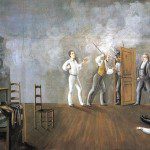A little more than a week ago, the Church of Jesus Christ of Latter-day Saints released an update to its online edition of the Bible and other authoritative texts, with a print edition to follow later this year. Some of these changes reflect better historical knowledge of LDS history, as well as improved study aids, and some historical contextualizing of some important LDS texts. The new edition of the LDS Bible is incremental, offering a few minor spelling and punctuation updates to the King James Version, the official translation approved of by the Church. The changes and the lack of changes have spurred some insightful reflection on the meaning of this new edition, including the supplemental resources it provides for study, but it is useful to consider at this junction just how exactly Mormons read the Bible.
Reading the Bible is not a self-evident endeavor, and Mormons, like other religious groups throughout history, have modes of reading that reflect their historical circumstances and distinctive concerns. More interesting than any particular exegesis of the Bible is the way that Mormons approach the Bible as a sacred text. Notably, Mormons reject biblical inerrancy, self-sufficiency, and the doctrine of sola scripture, hallmarks of other conservative American church movements. Mormonism is both a critique of these hermeneutical approaches, and even the biblical text itself in some ways. Problems with the Bible and gaps in its narrative are really the genesis of Mormonism itself, which offers the Restoration of the Gospel as the solution to the confusions and discord over biblical meaning.
Revising sacred texts is a long Mormon tradition, dating back to the founder Joseph Smith. Smith not only engaged in a revelatory quest to re-“translate” the Bible in his early career, but later took to learning Hebrew and other languages in his search to unlock an allusive meaning in the Bible clouded in historical accretions and the weight of traditional interpretation. Just as Smith sought to update the Bible, he brought the same revising eye to his own texts. He updated the revelations he received, first in the Book of Commandments, and then in the Doctrine and Covenants, in some cases drastically changing the meaning or expanding the original. Even the Book of Mormon underwent editorial changes under Smith’s direction in 1837, not just of spelling, but to clarify a few doctrinal matters in the text.
Focusing on these changes and revelations expanding the biblical narrative alone misses the broader significance of why Smith set out to reveal these things in first place. Early Mormonism saw itself as reliving the biblical past with the prophetic authority that inspired the biblical authors in the first place. The present is a new age of divine inspiration in the pattern of the biblical past. In this way, the “Restoration” brings the sacred past to the present in a creative appropriation of various elements braided together into the “fulness of time.” Prophets, temples, and apostles are not just features of a bygone era, but represent the way that God operates among his followers in all times. Even some of the more distinctive aspects of Mormonism, like proxy baptisms for the dead, the 19th century practice of polygamy, and early Mormon economic utopian communities are rooted in biblical precedent. Mormon history even has its own Exodus to a desert land with a salted sea.
Additional Mormon scripture beyond the Bible represents a more fulsome biblical narrative. The Book of Abraham and the revelations in the Book of Moses transform the beginning of Genesis from third person narratives to first-person accounts with new interpretations. The longest of these new scriptures, the Book of Mormon, begin with biblical history surrounding the Babylonian exile and the theological problem raised in the exilic and post-exilic context of God’s apparent abandonment of his covenant with Israel. The Book of Mormon addresses this problem via the gap in biblical history of the people of the Americas.
While these broad themes continue to define Mormonism, Joseph Smith’s readerly approach to the Bible is contrasted with a much more mundane approach today. For contemporary Mormons, Sunday School and seminary classes are primarily interested in devotional questions, where the texts are studied as guides to daily living and resources for facing the challenges of life. At least according to one recent survey, Mormons exhibit the highest biblical literacy of any Christian group in the United States. Despite this knowledge of the narrative, historical and dogmatic matters are relevant only as peripheral questions in LDS worship contexts. For most, scriptural reading is a matter of personal divination, what Terryl Givens has called “dialogic revelation,” where the text becomes a vehicle for insight into learning God’s will for the reader.
Even in this brief summary, it is necessary to say that there is no single way that Mormons read the Bible. In the 20th century, Mormon biblical reading practices have begun to engage with modernist and postmodernist readings developed since the Enlightenment. There have been a handful of LDS biblical scholars trained in graduate programs over the past six decades, and more and more are being trained today. These scholars, trained in historical critical methods, represent the diversity of biblical studies itself, with some taking more apologetic positions, while others call into question the historicity of just about everything. Alongside this group, a collection of LDS philosophers has recently taken to scriptural interpretation. Both the historical critics and the philosophers will have much to offer as many of these younger scholars come of age in the next decade.
Whether these new approaches will gain significant influence in the broader church remains to be seen. While the Church has shown signs of opening up its own history and reforming the way church instruction treats these matters, little attention has been paid to critical issues around the Bible. There are some signs of progress in this regard at Brigham Young University, where a handful of faculty hires have some awareness of critical biblical studies. There are even some biblical scholars taking taking academic jobs outside of BYU for the first time (like me). Despite this small changes, for the broader church more critical approaches to the text stand far off on the horizon. Whether this is a problem remains to be seen. The historical critical approaches pioneered by 19th century Germans have had little influence on most church-goers in other denominations too.
If the recent changes to the Bible offered in the 2013 edition of the LDS scriptures suggest anything about the leadership’s view of things, they don’t think much change is need to what they’ve been doing for a while now.











